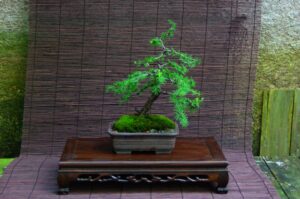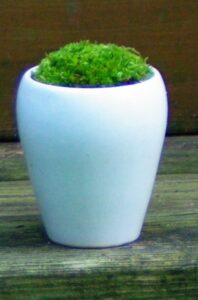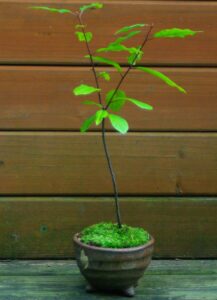KESHIKI bonsai – Fad or the future of bonsai
It is not surprising that in this fast-paced world powered by the internet, smart phones, tablets and mass-media the desire for instant gratification would eventually find its way into the bonsai community.
To be specific, “Keshiki Bonsai”, a “modern” bonsai style developed by Kenji Kobayashi in 2002. Kenji recognized almost everyone responds to the magic of a well-prepared bonsai composition. However, it takes a tremendous amount of time to learn the not only the horticulture but the complex rules of design and presentation. The creator of this”modern style” boasts all the complexities of the traditional styles are gone and you can create living works of art. The concept is taking your inspiration from a natural scene and replicating it in miniature with readily available plants and mosses.
Kenji recognized almost everyone responds to the magic of a well-prepared bonsai composition. However, it takes a tremendous amount of time to learn not only the horticulture but the complex rules of design and presentation. The creator of this”modern style” boasts all the complexities of the traditional styles are gone and you can create living works of art.
In this article I will be comparing some key aspects of this modern style with the more commonly accepted traditional styles. Does this new style really stack up to what it claims and is it really bonsai or is it something else?

Bonsai with a difference. – But is it really?
Traditional bonsai can trace its roots back to China (2205 – 255 BC). Some of the earliest records of bonsai in Japan date to 1300 AD. So clearly the rules and techniques have been developed and continuously refined over many years to what it is today.
Traditional bonsai, from a lay perspective is horticultural art that captures the essence of natural trees and stones and arranges them to proportion as occurs in the natural world but in a scale that can fit into a pot. However just planting trees in a pot without aesthetic judgment, maintenance, styling and you end up with just a potted plant not “art”.
The Keshiki style though greatly simplified still holds true to these concepts, you are creating a natural scene using natural scaled elements of plant, stone and moss within the confines in a small pot that is aesthetically pleasing. One still must maintain this modern form of bonsai in order to keep the original artistic design intact. The horticultural requirements for the plants must be maintained to keep them healthy.
So the difference does not appear to be on the horticultural side of the discussion.
What about the rules? are they really gone?
Traditional bonsai focus is about capturing the essence (feeling) of natural scene, for example an ancient tree barely clinging to life on edge of cliff on a high mountain side displaying all the battle scars from this rugged existence.
The artist achieves this through careful placement of viewing stones, the tree, companion plants and possibly a hand painted scroll. Strict rules prescribe all aspects of the composition even to the extent of how it is viewed. Central to the composition is a meticulously groomed tree styled to give the impression of great age.
The modern Style seems to be more focused on the present with no attempt to create the illusion of great age it is simply about capturing a natural scene. The Composition elements are a simple pot of a round variety plain, moss is used to simulate a carpet of fine grass typically there is a central plant as the main focal point. This can be a tree but can also be a perennial plant of unique character. There may be stones to simulate a walk way, path or other geographical feature however overall the focus is on simplicity
 Traditional larch bonsai |  Keshiki bonsai Moss |
This is where I think the traditional and modern styles diverge or at minimum there seems to be a relaxing of the traditional rules of composition. While most traditionalists would scoff at the idea of calling this “bonsai” the simplicity and feelings of peacefulness a simple pot of moss evokes would rival many traditional displays. What becomes readily apparent with this style is the simplicity really allows for true 360-degree viewing.
Bonsai with a difference -Summing it up
Based on the historical definition of what is or is not considered “bonsai”, I guess if you stretch the rules a tad this style fits both from the horticultural, philosophical design intent. The rules are not completely gone but they are greatly simplified. Scale and placement of the elements replicate in miniature natural scene. Trees or other prominent central elements are used. All the elements provoke a sense of harmony and continuity. Due to the simplicity of design viewing angles and front and back sides are far less rigid.

Living Art – In the eye of the beholder.
Can anyone do this and create a living work of art ? The concepts are simple enough however the key to bonsai is longevity. Bonsai are not considered disposable so keeping it alive and maintaining the original design becomes the challenge. So what happens over time with these creations ? The originator of the style really does not address the subject of what does one do as the plants age. Trees age lose their juvenile appearance outgrow their containers. So do you dispose of these older trees and replace them with new young ones or does this become the point where you have to learn the more traditional rules ?
Conclusion
After careful consideration in our view Kashiki bonsai is somewhat of a fad that may appeal to some younger generations and those individuals predisposed to needing instant gratification. The claims of complex ruled being eliminated is subjective but certainly there is less complexity as compared to traditional styles. I would agree it is bonsai with a difference and I believe the style may be a good stepping stone to the more traditional styles due to its simplicity.
As always we welcome your comments and feedback and will do our best to provide any support we can to enhance your bonsai journey. Contact us at (john@blackdodgebonsai.com)
John
POST YOUR COMMENTS